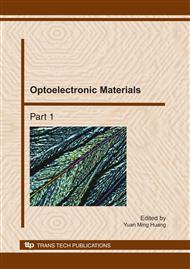p.64
p.68
p.72
p.76
p.80
p.84
p.88
p.92
p.96
High Precision Finishing Technique of Sapphire Substrate Surface for Photoconducting Device
Abstract:
Sapphire (α-Al2O3) single crystal, as an important photoconducting device substrate material, stringent surface quality requirements, i.e. surface finish and flatness, are required. The use of chemical mechanical polishing (CMP) technique can produce high quality surface finishes at low cost and with fast material removal rates. The polishing mechanism was studied in this paper, and it was pointed that there were chemical and mechanical kinetics process respectively. The chosen polishing temperature was 40 oC. SiO2 sol was chosen as abrasive and the particle size is 40nm. The pH value was determined at 11.5~12. During CMP process C6382I-W/YJ single side polisher and SUBA 600 pad were used. After polishing and cleaning of sapphire surface, the measured removal rate was above 183.3nm /min and the surface roughness by using AFM was lower than Ra 0.3 nm. From the results, it was found that using such method, the optimal sapphire surface can be gotten, which is advantaged for epitaxial growth and device making-up.
Info:
Periodical:
Pages:
80-83
Citation:
Online since:
November 2010
Authors:
Price:
Сopyright:
© 2011 Trans Tech Publications Ltd. All Rights Reserved
Share:
Citation:


